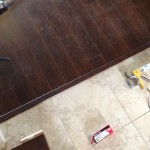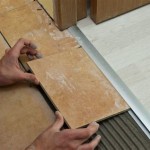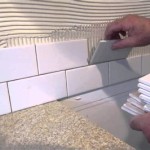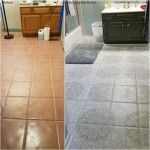Can You Put Lino On Top of Ceramic Tiles?
The question of whether linoleum (lino) can be installed directly over existing ceramic tiles is a common one among homeowners looking to update their floors. The answer is generally yes, it is possible, but it requires careful preparation and consideration of several factors to ensure a successful and long-lasting installation. Simply laying linoleum over ceramic tiles without proper preparation can lead to a host of problems, including uneven surfaces, trapped moisture, and ultimately, the premature failure of the linoleum flooring.
Linoleum is a durable and versatile flooring material made from natural components such as linseed oil, rosin, ground cork dust, wood flour, and mineral fillers, all pressed onto a burlap or canvas backing. It's known for its resilience, antibacterial properties, and environmental friendliness. However, its performance is highly dependent on a smooth, stable, and dry subfloor. Existing ceramic tiles, while potentially offering a solid base, present a unique set of challenges that must be addressed.
Before embarking on a linoleum installation over ceramic tiles, it is essential to thoroughly evaluate the condition of the existing tile floor. Any loose, cracked, or damaged tiles must be repaired or replaced. The surface must also be completely clean and free of any dirt, wax, grease, or other contaminants that could interfere with the adhesion of the linoleum. A deep cleaning followed by a thorough rinsing is highly recommended. After cleaning, the tiles should be inspected for any signs of moisture. Excess moisture can lead to mold growth under the linoleum and cause it to bubble or delaminate over time.
One of the primary concerns when installing linoleum over ceramic tile is the unevenness caused by the grout lines. These recessed lines can telegraph through the linoleum, creating an unsightly texture and potentially causing the linoleum to wear unevenly over time. Consequently, addressing the grout lines is a critical step in the preparation process.
Furthermore, the type of linoleum being installed plays a role in the suitability of this method. Thicker gauge linoleum, such as sheet linoleum, might be more forgiving over minor imperfections than thinner gauge linoleum tiles or planks. However, even with thicker linoleum, proper preparation is crucial.
Addressing Grout Lines for a Smooth Surface
The most common method for dealing with grout lines is to fill them with a cement-based patching compound or a self-leveling underlayment. These compounds are designed to create a smooth, even surface that eliminates the depressions caused by the grout lines. When using a patching compound, it is important to choose one that is specifically designed for filling grout lines and that is compatible with both ceramic tile and linoleum adhesives. The patching compound should be applied according to the manufacturer's instructions, typically involving multiple thin layers to avoid cracking or shrinking. After the patching compound has dried completely, it should be sanded smooth to create a seamless transition between the tiles and the filled grout lines.
Self-leveling underlayment offers another option for creating a smooth surface. This type of underlayment is a pourable liquid that spreads evenly and self-levels, filling the grout lines and creating a consistent surface. Self-leveling underlayment is generally more expensive than patching compound, but it can be a quicker and easier solution for larger areas. It is crucial to ensure the existing ceramic tiles are primed adequately before applying the self-leveling underlayment to promote proper adhesion. Furthermore, the underlayment should be allowed to cure fully before proceeding with the linoleum installation.
In addition to filling the grout lines, it is also important to consider the edges of the ceramic tile floor. If the tile floor is not perfectly level with the surrounding subfloor, feathering out the patching compound or self-leveling underlayment to create a smooth transition is necessary. This prevents a tripping hazard and ensures a visually appealing finish.
Selecting the Right Adhesive
Choosing the appropriate adhesive is critical for a successful linoleum installation over ceramic tiles. The adhesive must be compatible with both the linoleum and the ceramic tile surface. A high-quality, moisture-resistant adhesive is recommended to prevent the linoleum from lifting or bubbling due to moisture migration. It's important to consult the linoleum manufacturer's recommendations for specific adhesive types. Some adhesives are specifically designed for use with linoleum and may offer superior performance compared to general-purpose adhesives.
The adhesive should be applied evenly across the entire surface of the prepared ceramic tile floor, using the trowel size recommended by the adhesive manufacturer. Proper trowel size ensures that the correct amount of adhesive is applied, providing adequate bonding without creating excessive buildup. It is essential to follow the adhesive manufacturer's instructions regarding open time and working time. Open time refers to the amount of time the adhesive can be exposed to air before the linoleum is applied, while working time refers to the amount of time available to position and adjust the linoleum after it has been placed on the adhesive.
After the linoleum is installed, it should be rolled thoroughly with a heavy floor roller to ensure complete contact with the adhesive. This helps to eliminate air pockets and creates a strong bond between the linoleum and the subfloor. Any excess adhesive that squeezes out from the seams should be wiped away immediately with a damp cloth.
Consider using a pressure-sensitive adhesive for easier installation, especially for smaller areas. These adhesives are applied like a film or tape and provide a strong, instant bond. However, ensure the surface is perfectly smooth before applying a pressure-sensitive adhesive, as any imperfections will be immediately visible.
The Importance of Underlayment
While not always necessary, using an underlayment between the ceramic tile and the linoleum can offer several benefits. An underlayment can provide additional cushioning, reduce noise transmission, and help to even out minor imperfections in the subfloor. It can also act as a moisture barrier, preventing moisture from migrating through the ceramic tile and damaging the linoleum. When choosing an underlayment, it is important to select one that is specifically designed for use with linoleum and that is compatible with the adhesive being used.
Different types of underlayment are available, including felt, foam, and cork. Felt underlayment is a traditional option that offers good cushioning and sound absorption. Foam underlayment is a lightweight and affordable option that provides moderate cushioning. Cork underlayment is a more expensive option that offers excellent cushioning, sound absorption, and thermal insulation. The choice of underlayment will depend on the specific needs and budget of the project.
When installing an underlayment, it is important to follow the manufacturer's instructions carefully. The underlayment should be installed with the correct orientation and secured to the ceramic tile floor with staples or adhesive. Seams between sheets of underlayment should be taped to prevent moisture from penetrating.
Even when using an underlayment, addressing the grout lines is still recommended. While the underlayment can provide some cushioning and help to even out minor imperfections, it is not a substitute for proper subfloor preparation. Failing to fill the grout lines can still result in an uneven surface and premature wear of the linoleum.
In summary, installing linoleum over ceramic tiles is a viable option if the subfloor is properly prepared. Cleaning, filling grout lines, selecting the right adhesive, and considering the use of an underlayment are all important factors to consider. Careful attention to these details will ensure a successful and long-lasting linoleum installation.

Installing Luxury Vinyl Over Existing Tiles Choices Flooring

Transform Your Home Installing Vinyl Flooring Over Ceramic Tiles City Wall And Floor

How To Tile Over Linoleum Floors Correctly

How To Lay Vinyl Flooring Sheet Over Tiles

Can You Lay Tile Over Linoleum Rubi Blog Usa

Should You Install Vinyl Floor Over Tile

How To Install Vinyl Flooring Over Tiles Linoleum Thrift Diving

What Type Of Flooring Can You Install Over Ceramic Tile

Can I Lay Premium Vinyl Flooring Over A Tile Floor Hometalk

How To Install Vinyl Flooring Over Ceramic Tile Step By This Old House
Related Posts








